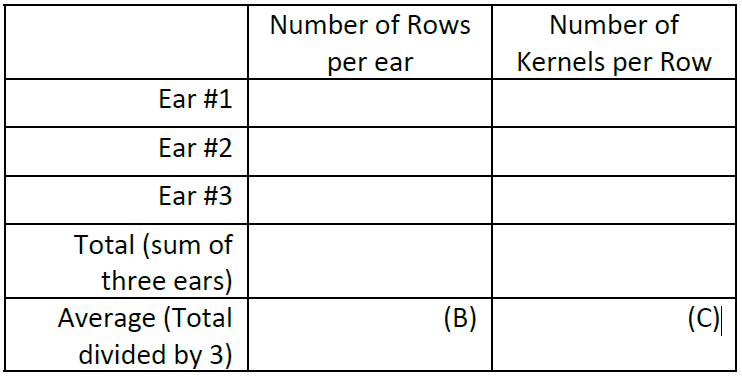Kelly Nichols, Agriculture Agent Associate
University of Maryland Extension, Frederick County
Corn
Estimating corn yield can be done in a few simple steps. You’ll need a measuring tape, pencil, and a notepad, or the worksheet below. In order to get the best estimate, it is recommended to take several samples from representative areas of the field.
Step 1. Measure 1/1000th of an acre. If you have 30-inch rows, you will need to measure 17.4 feet. If your row spacing is different, take 43.56 sq. ft./A divided by the row spacing in feet. For example, a 20-inch row spacing is 1.67 feet. 43.56 ÷ 1.67 = 26.1 feet, so you’ll need to measure 26.1 feet of the row.
Step 2. Count the total number of ears in the measured section of the row.
Write the number of ears here: ________________ (A)
Step 3. On three different ears, count the number of rows per ear, as well as the number of kernels per row. Do not count aborted or damaged kernels, as they will not contribute to yield. Next, calculate the total and the average. The picture below shows the direction to count in for each measurement.

Step 4. Calculate the number of kernels per ear. To do this, multiply the average number of rows per ear (B) by the number of kernels per row (C) from Step 3.
___________ rows per ear (B) X _______________ kernels per ear (C) = __________ kernels per ear (D).
Step 5. Calculate the number of kernels per acre. Multiply the number of kernels per ear (D) by the number of ears (A) by 1,000.
___________ kernels per ear (D) X ________ number of ears (A) X 1,000 = ________ kernels per acre (E).
Step 6. Estimate yield at 15.5% moisture. Divide the number of kernels per acre (E) by 90,000 kernels/bu.
________ kernels per acre (E) ÷ 90,000 = ________ estimated bu/A.
Step 7. If you would like to estimate silage yield, Penn State Extension suggests dividing the estimated grain yield by a factor of 6.5 to 7.5. This will provide an estimate of wet tons at 35% dry matter.
Soybean
Just a few notes on estimating soybean yield. In order to reduce variability of soybean yield estimates, sample more than five areas in a field. (However, this can be time-consuming.) Also, wait until the soybeans have reach at least the R6 growth stage; at this growth stage, the soybeans have green pods with seeds that fill the pod. This will provide a more realistic yield estimate.
Estimating soybean yield involves counting the number of pods in a specified area of the field. You will also need the number of seeds per pod (2.5 can be used as a conservative estimate), as well as the seed size factor. There are two excellent resources which explain the steps of estimating soybean yield:
1) Estimating Soybean Yields – Simplified: a fact sheet by Dr. Shaun Casteel, Purdue Soybean Extension Specialist.
2) Estimating Soybean Yields: a video by Dr. Liz Bosak, Penn State Extension Field & Forage Crops Educator.
